2004 VOLKSWAGEN GOLF PLUS inflation pressure
[x] Cancel search: inflation pressurePage 219 of 541
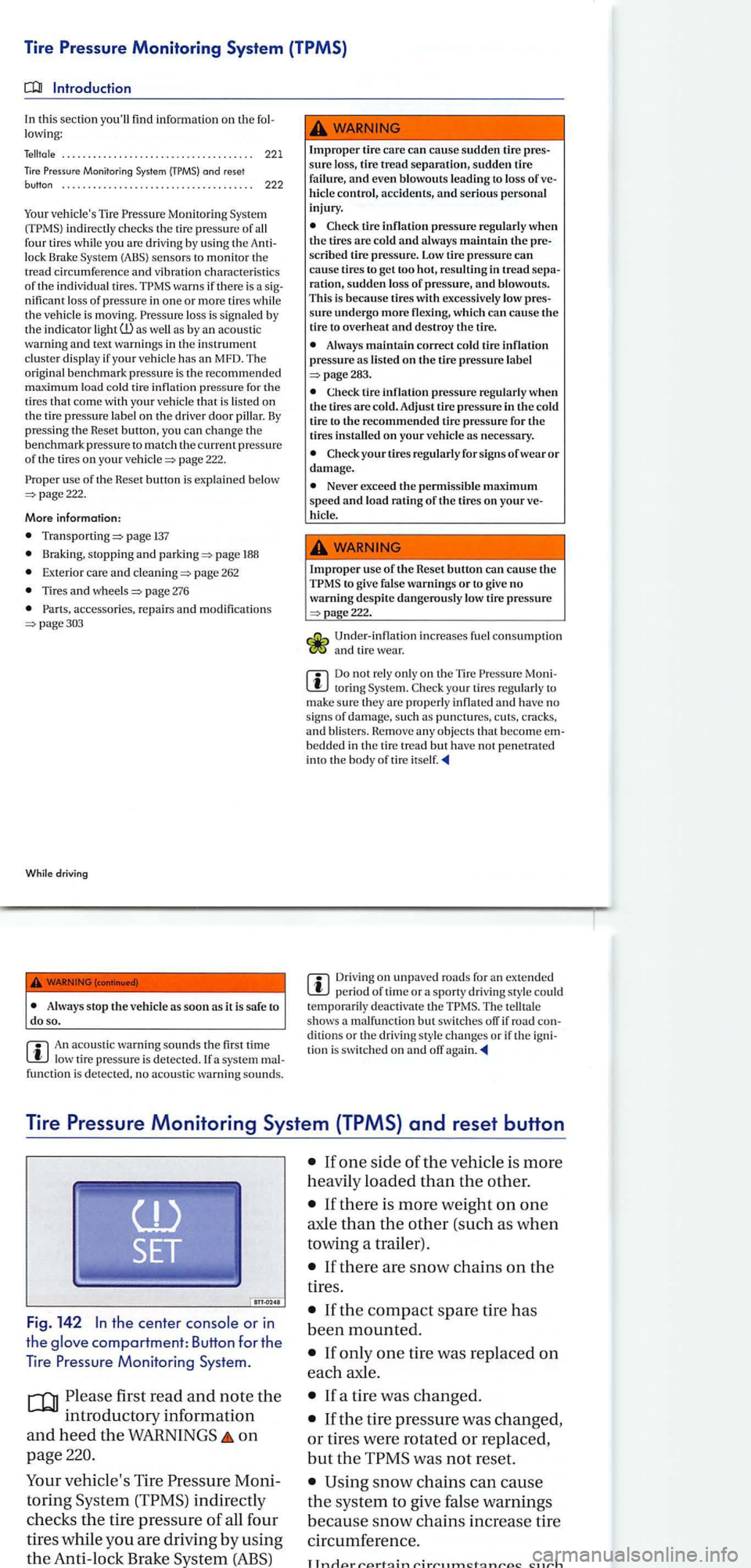
Tire Pressure Monitoring System (TPMS)
this section you'll find informati on on th e lowing:
. . . . . . . . . . . . . . . . . . . . . . . . . . . . . . . . . . . . . 221
Monitor ing System
Monito ring Sys te m indirectly c hecks the tire pressure of all
f our tires while you are driving by us ing the lock Brake Syste m (ABS) sensor s to monitor the
tr ea d circumf erenc e and vibration ch arac te ris tics of the indi vidua l tir es. warns if there is a nifi cant loss of pres sure in one or more tires while
the vehicl e is mo vin g. loss is s ig nale d b y
the ind icato r light as by an aco usti c
wa rni ng and text warnin gs in the in strument clu ster di spla y if your ve hicle has an MFD. The
origina l b en chmark pre ssure is th e recommended
m axi mum load cold tire inflati on pressure for the tire s that come with your vehicle that is lis te d on
th e tire pressure lab el on the dri ver door pill ar. By press ing the Reset button , yo u can ch ange the
b enchmark pressure to match th e c urr ent pressure of the tir es on you r page 222.
use of the Heset butto n i s explained below 222.
More informa tion:
page 137
Bra king, stopping and page 188
Ext e rior care an d page 262
page 276
pa ge303
Whil e driving
An acoustic warni ng sounds th e first time low tire pressure is detec ted. a system
Improp er tire care can cause sudden tire sure loss,
hicle control, accidents, and serious personal
injury .
tire inflation pressure regularl y when the tires are cold and alway s maintain the scribed tire pressure . Low tire pressure can cause tires to get too hot, res ultin g in tread ration, sudden lo ss of pres sure, and blowout s.
Thi s is because tires with excessively low
sure undergo more flexi ng, which can cau se the tir e to overheat and destroy the tire.
Always maintain correct cold tire inflation pressure as listed on the tire pressure label
Check tire inflation pressure regularl y when the tires are cold. Adjust tir e press ure in the cold
tir e to the recommended tire pressure for t11e tires installed on your vehicl e as necessary.
Neve r exceed the permissi ble maximum speed and load rating of the tires on your hicl e.
Imprope r us e of the Reset button can cause the to give false warnings or to give no
warning des pite dangerou sly lo w tire pressure
page222.
Und er- inflat ion increases fue l con sumptio n and tire wear.
to ring Syste m.
bedde d in the tir e tre ad but have n o t penetrated
int o the body of tire
Driving on u npaved roads for an extended
The te lltal e
s h ows a malfunc tion but switch es orr if road dit io ns or th e drivin g sty le c han ges or if th e tio n is switch ed on and orr
Tire Pressure Monitoring System (TPMS) and reset button
the center or in
the compartment: Button for th e
T
ire Pressure Monitoring System.
first r ead and note the
introductory informatio n
and heed the WARNINGS on
page
ve hicle's Tir e Moni
torin g
indirectly
c h ec ks
the ti re pressure of al l four
tire s while yo u are drivin g by us
ing
the Anti -loc k
If there is more weight on one
axle than the other (such as when
towin g a trailer) .
Page 220 of 541
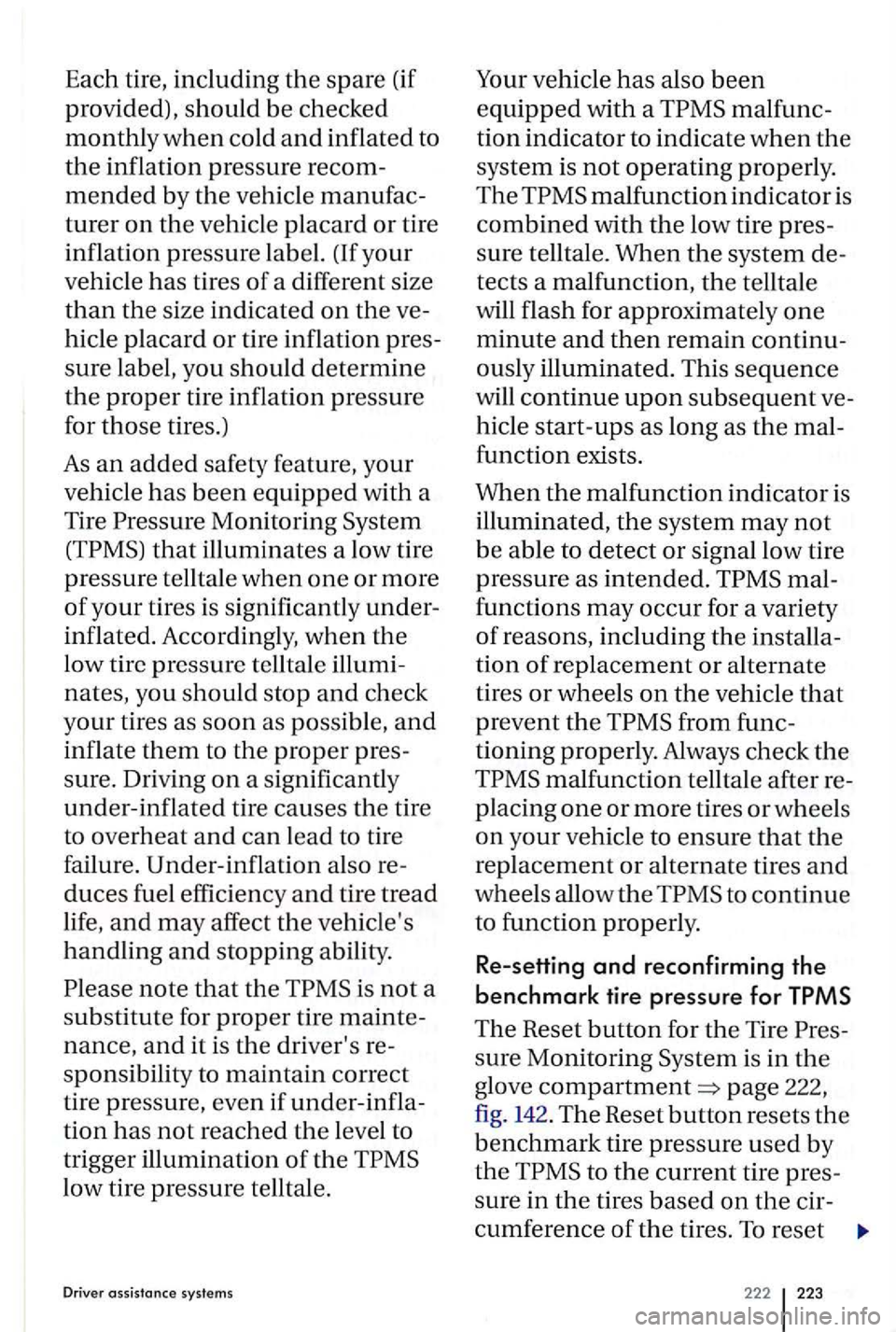
Each tire, including the spare (if
provided),
should be checked
monthly w hen cold and inflated to
the inflation pressure recom
mended by the vehicle manufac
turer
on the vehicle placard or tire
inflation pressure label.
(If your
vehicle
has tires of a different size
than the size indicated on the ve
hicle placard
or tire inflation pres
sure label, you sho uld determine
the proper tire inflation pressure
for
those tires.)
As an added safety feature, your
vehicle
has been equipped with a
Tire
is not a
substitute for proper tire mainte
nance,
and it is the driver's re
sponsib ility to
maintain correct
tire pressure , even if under-infla
tion
has not reached the level to
trigger illumination
of the
low tire pressure telltale.
Driver assistance systems
Your vehicle has also been
equipped with a malfunc
tion indicator to indicate
when the
system is not operating properly.
The
malfunction indicator is
combined with the low tire pres
sure telltale. When
the system de
tects a malfunction, the telltale
will flash for approximate ly
one
minute and then remain continu
ously illuminated. This sequence
will continue upon subsequent ve
hicle
start-ups as long as the mal
function exists.
When
the malfunction indicator is
illuminated, th e system may not
be able to detect or signal low tire
pressure
as intended.
to continue
to function properly.
Re-setting and reconfirming the
benchmark tire pressure for TPMS
The Reset button for the Tire
sure Monitoring is in the
glove compartment=> page 222,
fig. 142. The Reset button resets the
benchmark tire pressure used by
the
to the current tire pres
sure
in the tires based on the cir
cumference
of the tires. To reset
222 223
Page 221 of 541
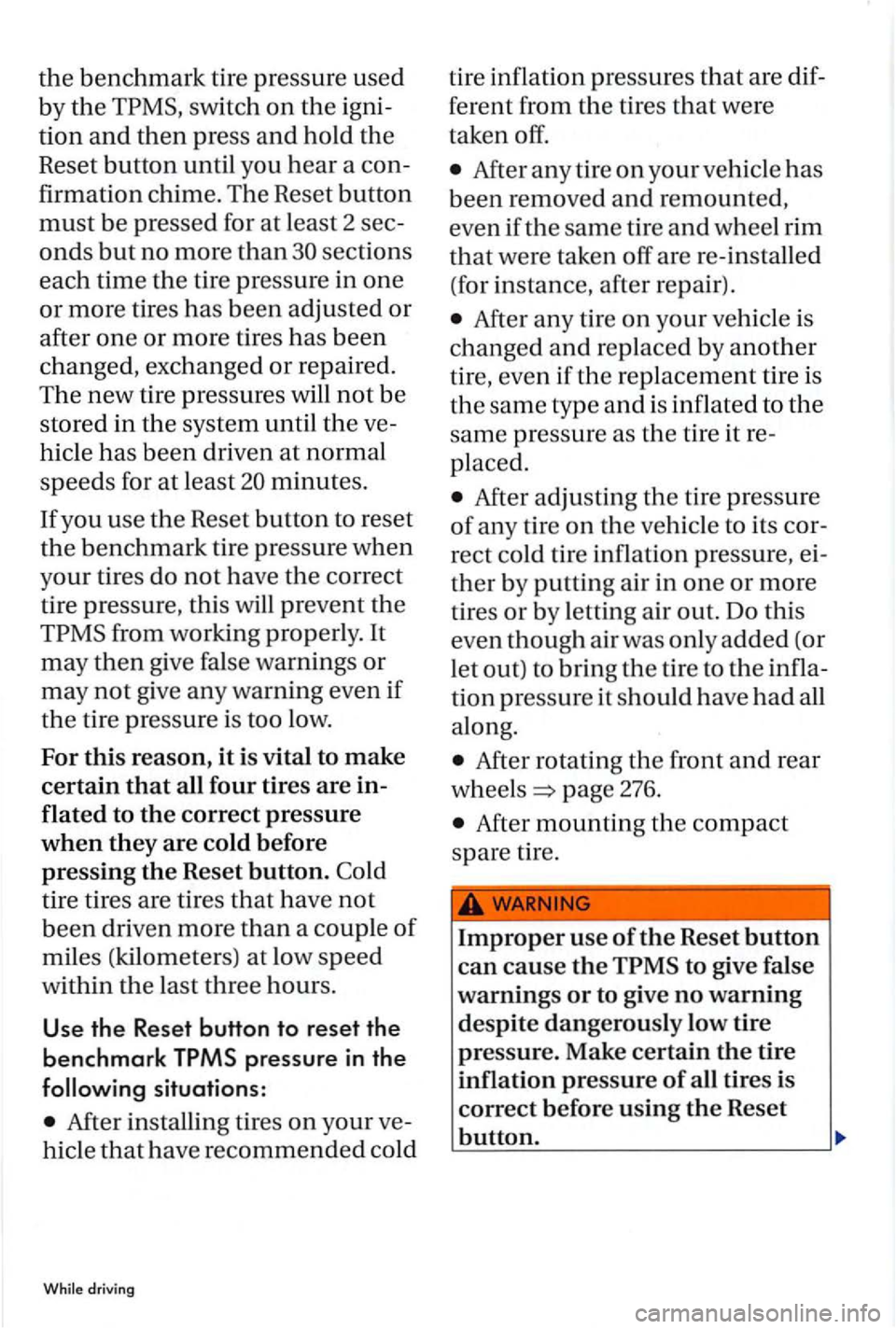
the benchmark tire pressure used
b y
the swi tch on the igni
tion
and then press and hold the
Reset button until you hear a con
firmation chime. The Reset button
must be pressed for at least 2 sec
onds but no more than sect ions
each time
the tire pressure in one
or more tire s has bee n adjusted or
after
one or more tires has been
changed, exchanged or r
epaired.
The new tire pressures will not be
st
ore d in the system until the ve
hicle has b
een driven at normal
s p eeds for
at leas t minutes.
If you use the Reset button to reset
the ben chmark tire pressure when
yo
ur tires do not have the corre ct
t ir e pressure, this
will prevent the
After installin g tires on your ve
hicle
that h ave recom mended co ld
driving
tire infl ation pressures that are dif
ferent from the tires that were
taken off.
After any tire on you r ve hicl e has
b
een removed and remounted,
even if t he sa me tire
and w hee l rim
that were taken off are re-insta ll ed
(for instance, after repair).
After a ny tire on you r veh icle is
changed
and r ep lace d by another
tire, even if th e rep lace me
nt tire is
th e
same type and is inflated to the
same press ure as the tir e it re
pl ace d.
After adjusting the tire pressure
of an y tire on the ve hicl e
to its cor
rect cold tire in flation pressure, ei
ther by putting air in one or more
tires
or by let tin g air out. Do this
even though air was o
nly added (or
let out)
to bring the tir e to the infl a
tion pressure it should have had all
along .
After rotating the front and rear
w he els
page 276.
After mounting th e compact
s pare tir
e.
Improper use of the Reset button
can cause the to give false
warnings
or to give no warning
d espite dangerously low tire
pressure. Make certain
the tire
inflation pressure
of all tires is
correct before using
the Reset
button.
Page 274 of 541
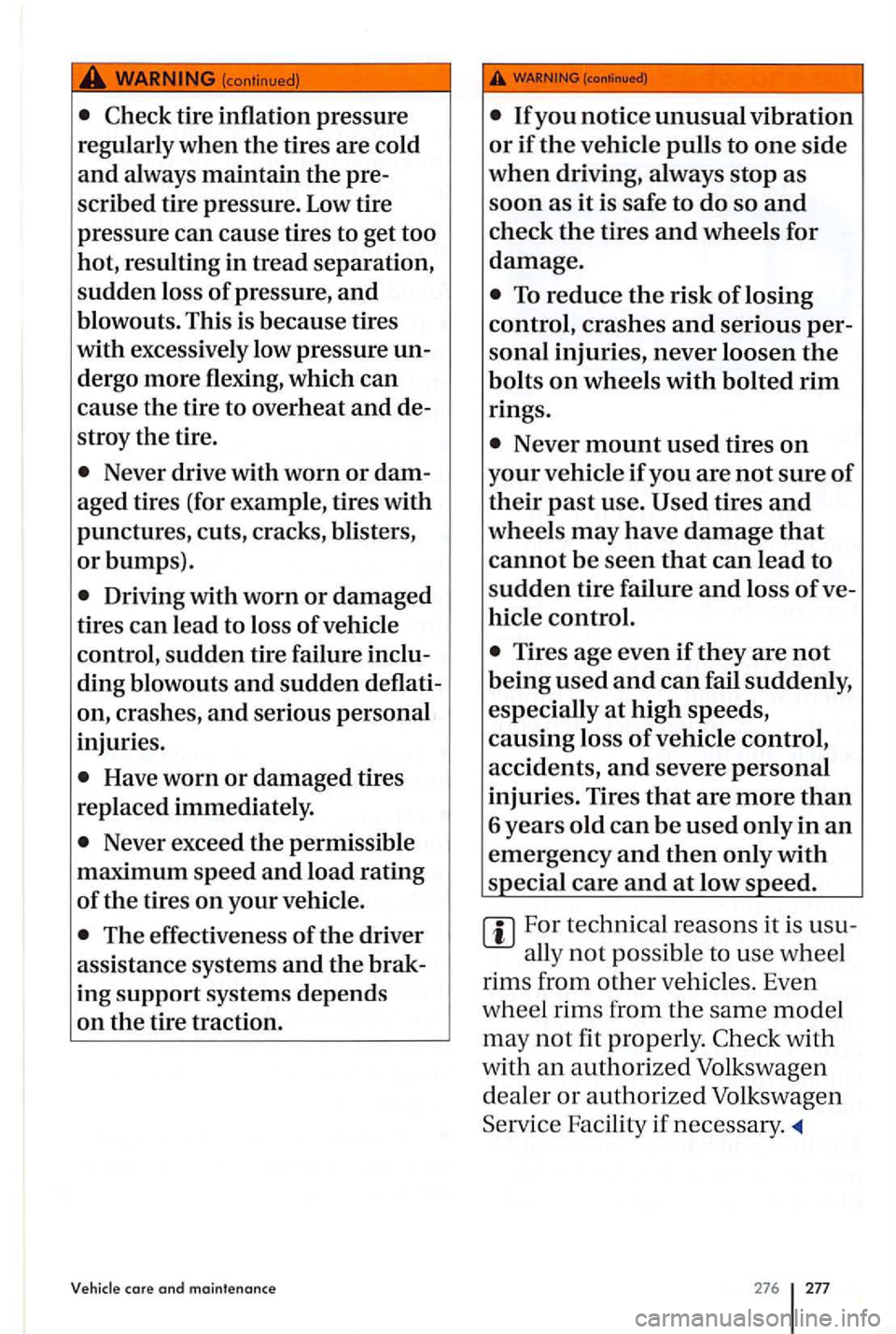
(contin ued )
tire inflation pressure
regularly when
the tires are cold
and always maintain the pre
scribed tire pressure .
Low tire
pressure
can cause tires to get too
hot, resulting in
tread separation,
sudden loss of pressure , and
blowouts . This is because tires
with excess ively low pressure
un
dergo more flexing, which can
cause the tire to overheat and de
stroy
the tire.
Never exceed the permissible
maximum speed
and load rating
of the tires on your vehicle.
The effectiveness of the driver
assistance systems
and the brak
ing
support systems depends
on the tire traction.
care and maintenance
To reduce the risk of losing
control,
crashes and serious per
sonal injuries, never loosen the
bolts on wheels with bolted rim
rings.
Never mount used tires on
your vehicle if you are not sure of
their past use.
Tires age even if they are not
being used and can fail suddenly,
especially
at high speeds,
causing loss of vehicle control,
accidents,
and severe personal
injuries. Tires that are more than
6 years old can be used only in an
emergency and then only with
special care and at low speed.
For technical reasons it is usu-
ally
not possible to use wheel
rims from other vehicles. Even
wh eel rims from
the same model
may not fit properly.
Fac ility if necessa1y.
276
Page 280 of 541
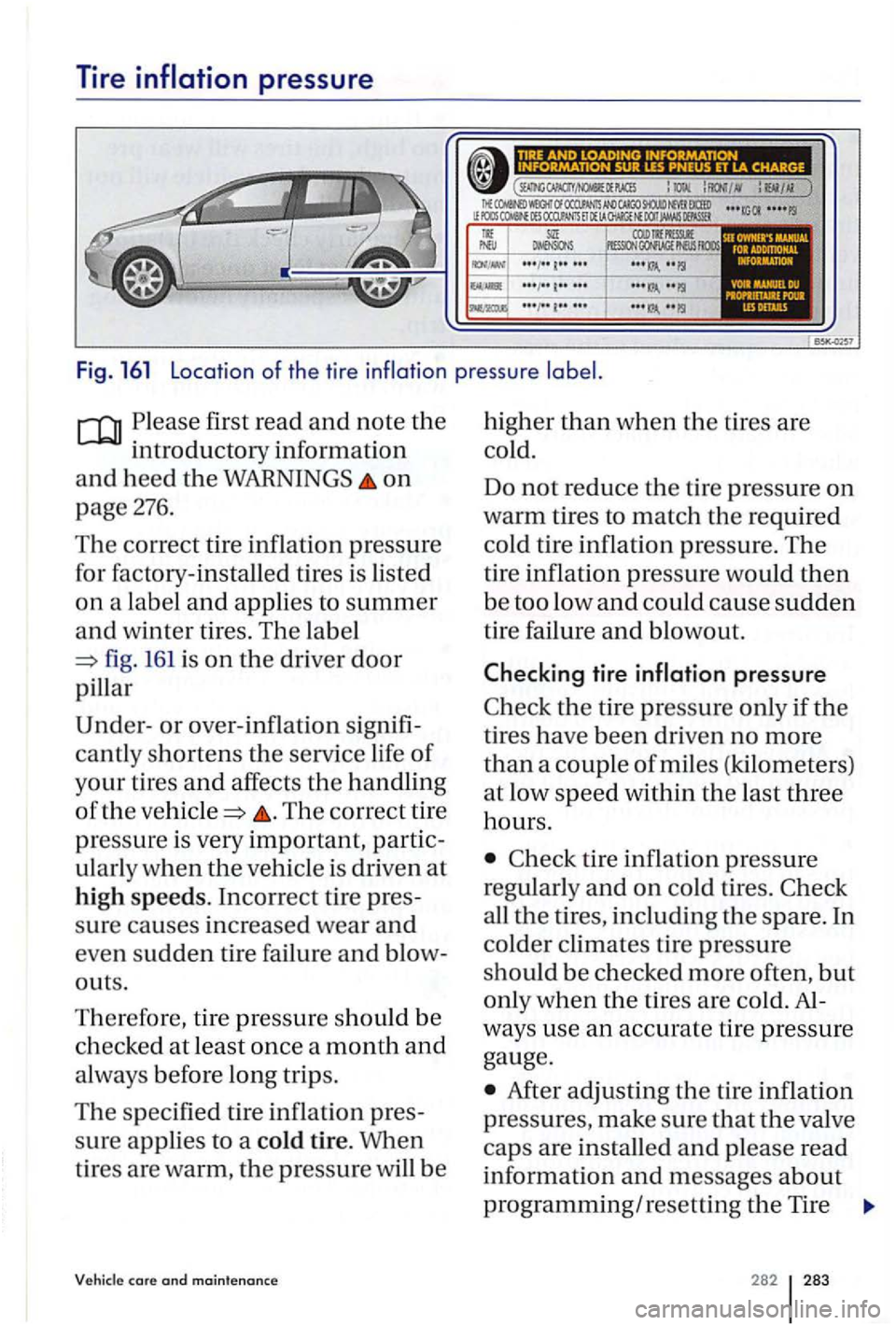
Tire
first read and note the
introduc to ry in
formation
a
nd h ee d the WARNINGS on
page 276.
T he c orr ec t tir e infl atio n
pressure
f o r f ac
tory-install ed tires is lis te d
o n a la b el a
nd a ppli es to summer
and wint er tir es. T he la b el
fig. 161 is on the dri ver door
pillar
Chec k tir e infl ati on pressure
r eg ula
rly a nd on cold tires . C heck
al l
the tir es, includin g th e s pare. In
co l
der clim ates tire pressure
s h ould be c hec k
ed more o ften , but
only w hen th e tir es are c old . Al
w ays use an a cc
urate tir e pressure
ga uge .
Afte r adju stin g tl1e tire inflation
pressures, make sure th at the valve
ca ps a re i
nsta ll ed and please read
informati on and m essages about
programming/rese ttin g th e Tir e
282
Page 281 of 541
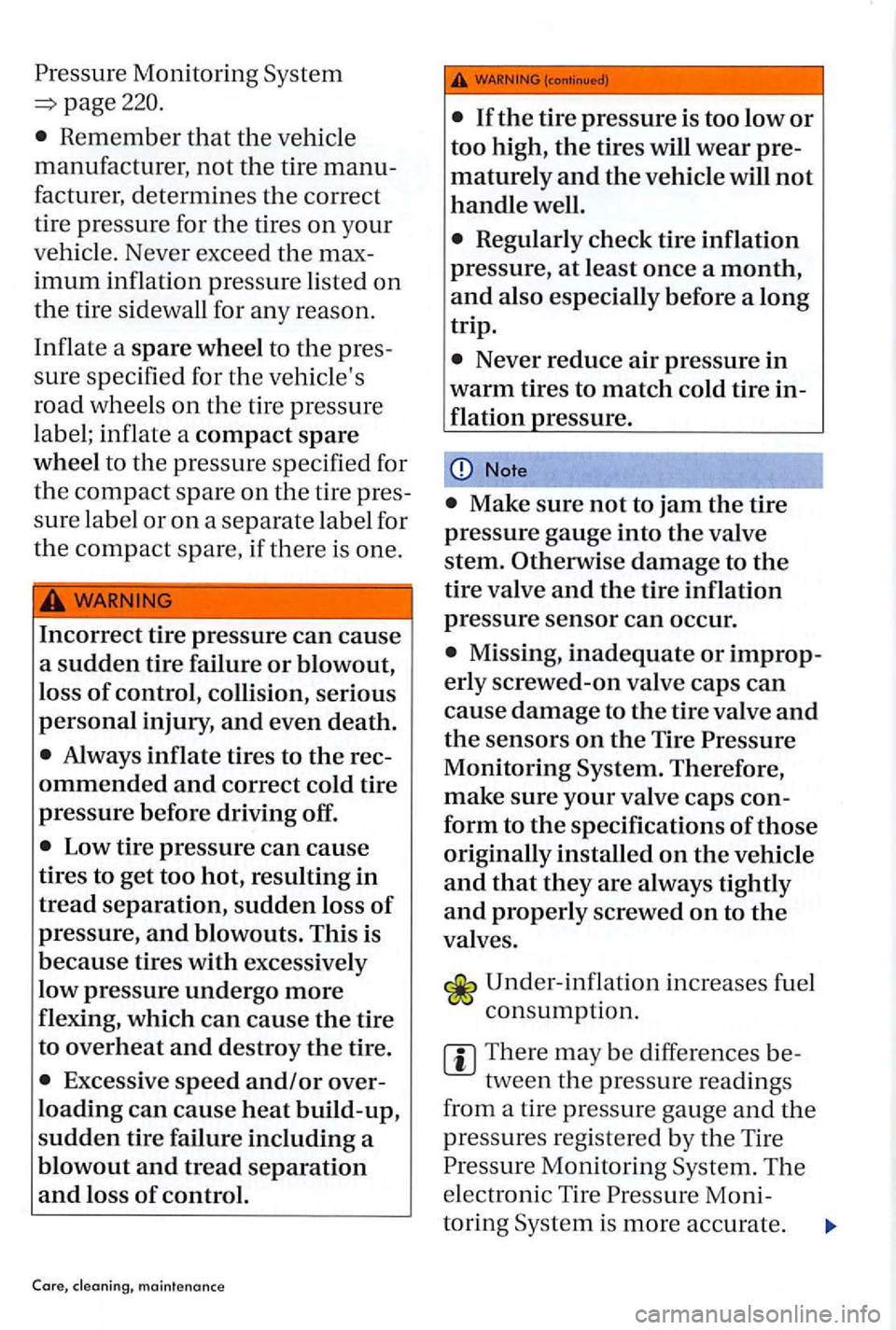
page220.
Remember that the vehi cle
manufacturer, not the tire manu
facturer, determines the correct
tire
pressu re for the tires on your
ve hicl
e. Never exceed the max
imum inflation pressure listed on
the tire s idewa ll for any reaso n.
Inflat e a
spare wheel to the pres
sure specif i
ed for the vehicle's
road whee ls
on the tire pressure
label; inflate a
compact spare
wheel to the pressure specified for
the compact spare on the tire pres
sure label
or on a separate label for
the compact spare, if there is one.
Incorrect tire pressure can cause
a
sudden tire failure or blowout,
loss
of control, collision, serious
personal injury, and even death.
Always inflate tires to the rec
ommended and correct cold tire
pressure before driving off.
Excessive speed and/or over
loading
can cause heat build-up ,
sudden tire failure including a
blowout
and tread separation
and loss of control.
maintenance
If the tire pressure is too low or
too high, the tires will wear pre
maturely and the vehicle will not
handle well.
Regularly check tire inflation
pressure, at least once a month,
and also especially before a long
trip.
Note
increases fuel
There may be differences be-
tween the pressure readings
from a tire pressure gauge
and the
pressures registered by the Tir e
Monitoring System. The
e lec tronic Tire
Moni-
toring System
is more accurate .
Page 282 of 541
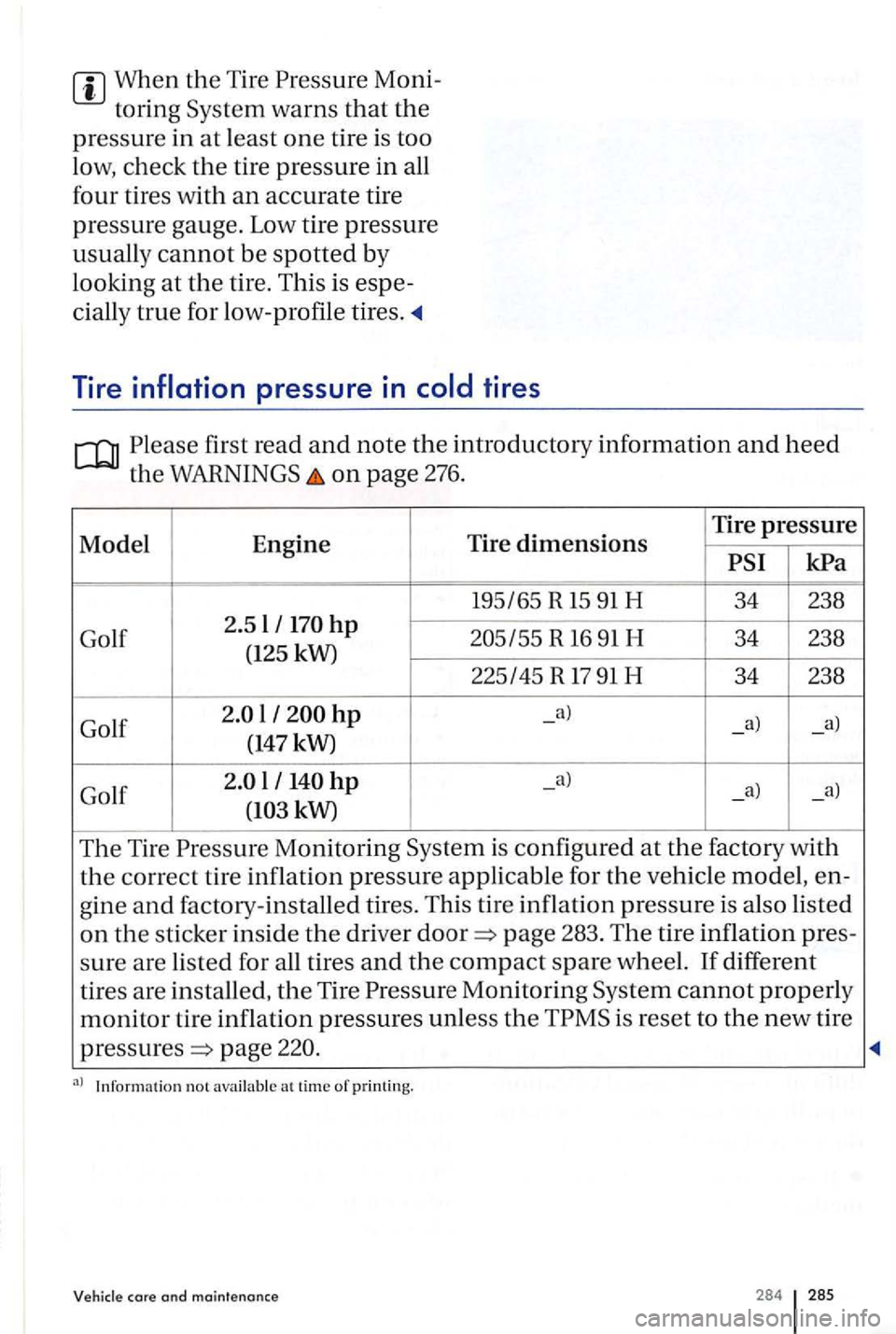
When the Tire
first read and note the introductory information and heed
the on page 276.
Model Engine Tire dimensions Tire pressure
R 16 91 H 34 238
(125 kW)
225145 R
17 91 H 34 238
Golf
l -
The Tire is confi gured at the factory with
the correct tir e inflation pressure applicabl e for the ve hicl e model, en-
g in e
and factory-install ed tire s. This t ire inflation pressure is also listed
on the sticke r insid e the driver page 283 . The tire inflation pres -
s
ure a re listed for all tires and the compact spare wheel. If diff ere n t
tires are
installed, the Tire Monitoring cannot properly
monitor tir e inflation pressures unl ess the is reset to the new tire
page
Informatio n n ot availa b le at t ime o f printing.
Vehicle core and maintenance 284 285
Page 285 of 541
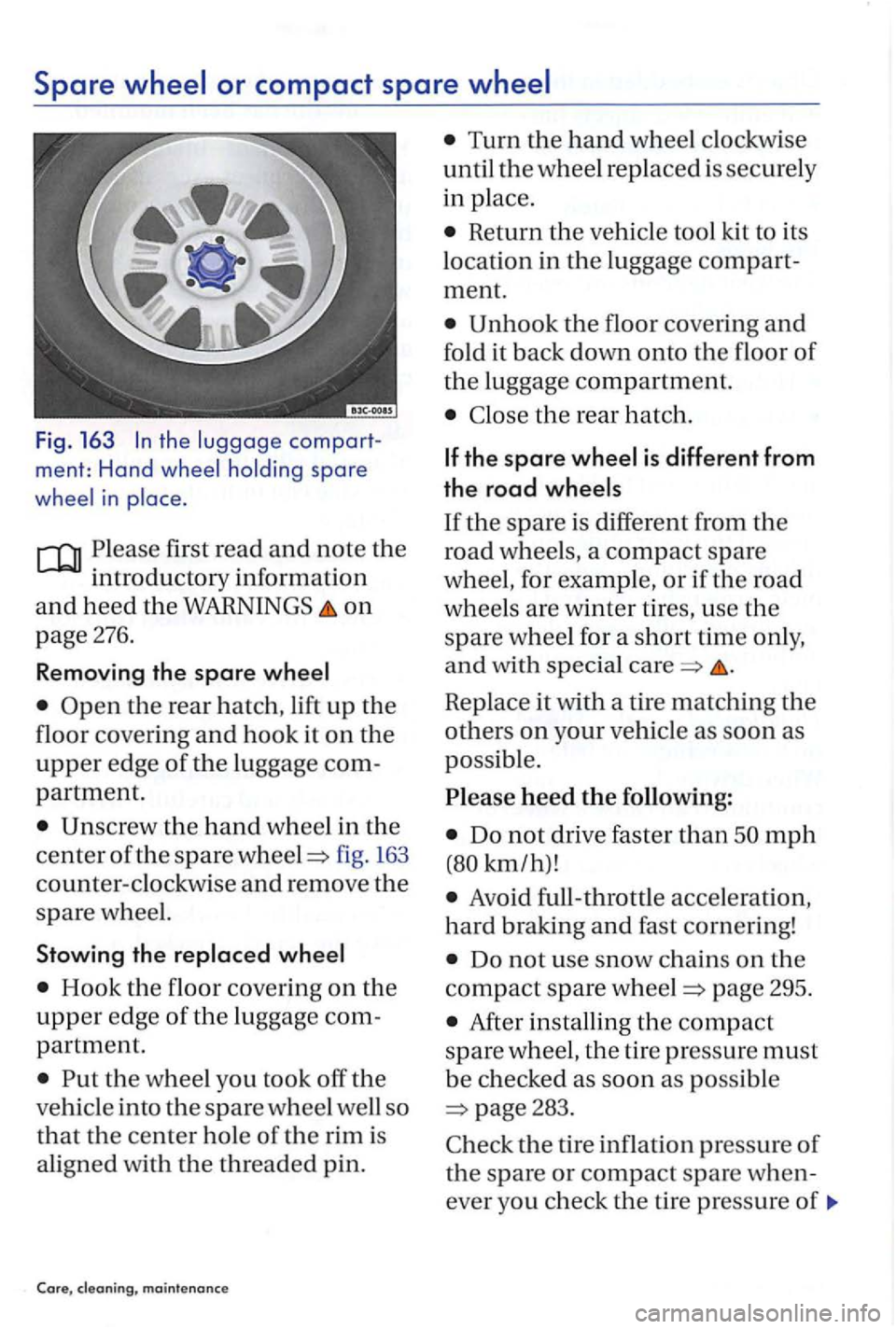
Spare
the compart
ment: Hand
Please first read and note the
introductory information
and heed the WARNINGS on
page 276.
Removing the spare
fig . 163
counter-clockwise and remove the
spare wheel.
Stowing the replaced wheel
Hook the floor cover ing on the
upper edge of the luggage com
partment.
Turn the hand wheel clockwise
until
the wheel replaced is securel y
in place .
Return the vehicle tool kit to its
location in
the luggage compart
ment.
the floor covering and
fold it back down onto the floor of
the luggage compartment.
Close the rear hatch.
Rep lace it with a tire matching the
others on your vehicle as soo n as
poss ible.
Please heed the following:
Do not drive faster than mph
km/h)!
Avoid full-throttle acceleration,
hard braking and fast cornering!
Do not use snow chains on the
compact spare whee l page 295.
After installing the compact
spare wheel, the tire pressure must
b e checked as soon as possib le
283.
Check
the tire inflation pressure of
the spare or compact spare when
ever you ch eck
the tire pressure of